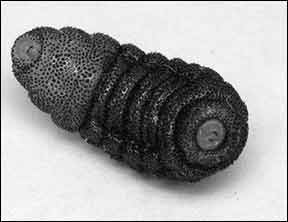Most owners know the parasites that can bedevil their cats, including fleas, ticks, mites and an abundance of worms. A lesser-known parasite, with far greater impact, is cuterebra (kyüt-ә-`rç-brә). They’re larva from adult botflies that can burrow under a cat’s skin or, more alarmingly, enter through the nose and migrate to the brain.

288
The threat of infestation is not widely known for two reasons, says parasitologist Dwight Bowman, Ph.D., professor in the Department of Microbiology and Immunology at Cornell University College of Veterinary Medicine. “It tends to be more rural than urban and suburban.” And the flies are prevalent only in the Western and Northeast U.S., and Southeastern Canada.
High-risk Infection. However, a cuterebra infestation has a distinguishing feature in cats that owners should be aware of: “If it ends up developing its lesion in the skin and migrates deep into the cat’s body, it is lethal. The effects are neurologic,” the form of infestation veterinarians tend to see in the Northeast, Dr. Bowman says. “Less significant infestations are subcutaneous big maggots the size of the end of the thumb under the skin.”
“Cuterebra don’t lay eggs on cats,” Dr. Bowman says, explaining that adult flies deposit eggs near rabbit and rodent burrows and runs. Larvae — small maggots — hatch from the eggs and can attach to a passing cat who’s exploring or hunting.
In the next step, the maggot crawls through the cat’s body, making its way back to the skin from the inside. It then develops a cyst with a breathing hole in the center that is visible to the naked eye. It’s easy for owners to spot this infestation: “There’s a lump under the skin,” Dr. Bowman says. A purulent discharge may also be seen around the opening.

288
He cautions that owners should not try to remove the parasite. “If you see one, go to a veterinarian. You can’t control it if it breaks.” Complications such as chronic infections can develop if the larva isn’t removed in one piece. Anecdotal reports have also cited cases of anaphylactic reactions.
Using a local anesthetic and scalpel or surgical scissors, the veterinarian will remove the cuterebra, disinfect the area and perhaps prescribe antibiotics. The prognosis for recovery is generally favorable.
If not removed, the larva will exit the skin in about 30 days, drop to the ground, pupate and become an adult fly.
Neurologic Damage. Cases in which cuterebra enter the nose, mouth, eye, anus or vulva and migrate to the brain or spinal cord have a guarded prognosis, Dr. Bowman says. That’s because the signs don’t appear early. Cats may show minimal respiratory problems regardless of the orifice the larva used to enter the body. It’s only when a full-blown case of a disease called feline ischemic encephalopathy (FIE) develops that signs become evident. Damage to the middle cerebral artery and other areas of the brain can result in seizures, circling and aggression. “There also can be spinal paralysis and blindness in one eye,” Dr. Bowman says.
Veterinarians use urine and spinal fluid tests to diagnose FIE, but the most effective diagnostic tool is a CT scan. If the maggot is accessible, veterinarians can surgically remove it in some cases. Drug treatment can kill the parasite in all the stages of the infestation but a cat’s reaction is a concern even when the maggot is only under the skin. Other medications can ease the signs of the infestation and help prevent seizures. And with proper identification and treatment of the infestation, some cats do recover.



